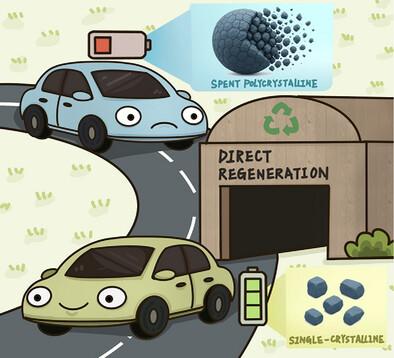Recycling Spent Lithium-Ion Layered Cathodes: Toward Direct Single-Crystalline Regeneration Technology
IF 26
1区 材料科学
Q1 CHEMISTRY, PHYSICAL
引用次数: 0
Abstract
Direct single-crystalline regeneration (DSCR) techniques of layered cathodes in lithium-ion batteries have attracted considerable research attention. Nonetheless, current development and commercial application of DSCR techniques remain constrained by different failure conditions of cathode materials, the complexity of production processes, and the opacity of evaluation systems. Herein, recent works on DSCR techniques applied to spent layered cathodes are summarized and compared. First, the failure mechanism of LiCoO2 (LCO) and Ni-based cathodes (NCM and NCA) is discussed, followed by a critical assessment of the current advantages and challenges of single-crystalline cathodes. Considering the different Li supplement and Ni contents, the electrochemical performance for the reported regenerated of LCO, Ni-lean, Ni-medium, and Ni-rich cathodes is separately studied and compared. Based on comprehensive evaluation and comparison, a multi-dimensional feasibility and strategy analysis for the development direction of targeted single-crystalline products and manufacturing techniques is provided. Finally, a prospect for future developments and challenges for the DSCR processes is further provided, with the hope of inspiring further advances toward the green and sustainable regeneration of spent lithium-ion batteries.

回收废锂离子层状阴极:走向直接单晶再生技术
锂离子电池层状阴极的直接单晶再生(DSCR)技术引起了广泛的关注。然而,目前DSCR技术的发展和商业应用仍然受到阴极材料不同失效条件、生产过程的复杂性和评估系统的不透明性的限制。本文对近年来应用于废层状阴极的DSCR技术进行了综述和比较。首先,讨论了LiCoO2 (LCO)和ni基阴极(NCM和NCA)的失效机制,然后对当前单晶阴极的优势和挑战进行了批判性评估。考虑不同的Li补充量和Ni含量,分别研究和比较了LCO、Ni-lean、Ni-medium和富Ni阴极再生后的电化学性能。在综合评价和比较的基础上,对定向单晶产品和制造技术的发展方向进行了多维度的可行性和策略分析。最后,对DSCR工艺的未来发展和挑战进行了展望,希望能进一步推动废旧锂离子电池的绿色可持续再生。
本文章由计算机程序翻译,如有差异,请以英文原文为准。
求助全文
约1分钟内获得全文
求助全文
来源期刊

Advanced Energy Materials
CHEMISTRY, PHYSICAL-ENERGY & FUELS
CiteScore
41.90
自引率
4.00%
发文量
889
审稿时长
1.4 months
期刊介绍:
Established in 2011, Advanced Energy Materials is an international, interdisciplinary, English-language journal that focuses on materials used in energy harvesting, conversion, and storage. It is regarded as a top-quality journal alongside Advanced Materials, Advanced Functional Materials, and Small.
With a 2022 Impact Factor of 27.8, Advanced Energy Materials is considered a prime source for the best energy-related research. The journal covers a wide range of topics in energy-related research, including organic and inorganic photovoltaics, batteries and supercapacitors, fuel cells, hydrogen generation and storage, thermoelectrics, water splitting and photocatalysis, solar fuels and thermosolar power, magnetocalorics, and piezoelectronics.
The readership of Advanced Energy Materials includes materials scientists, chemists, physicists, and engineers in both academia and industry. The journal is indexed in various databases and collections, such as Advanced Technologies & Aerospace Database, FIZ Karlsruhe, INSPEC (IET), Science Citation Index Expanded, Technology Collection, and Web of Science, among others.
 求助内容:
求助内容: 应助结果提醒方式:
应助结果提醒方式:


